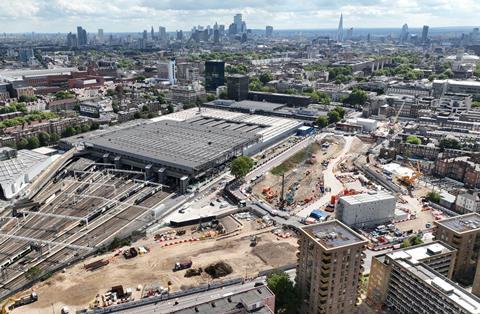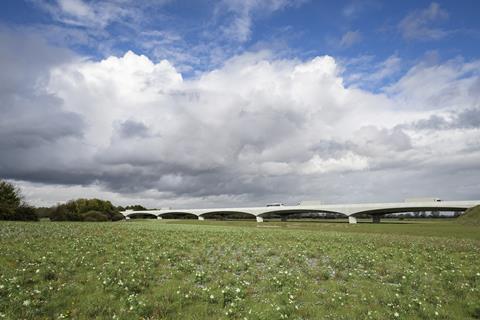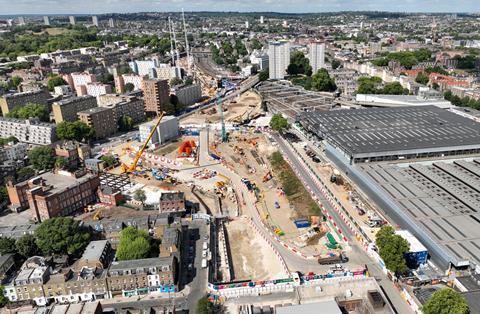The government has said it will fund the giant Euston station and Lower Thames Crossing schemes using private finance. With the Treasury mulling a broader injection of private capital into public projects, Joey Gardiner examines how ministers are going about it ŌĆō and the prospects for success


News that the government is considering restarting the regular use of private finance to pay for public infrastructure has got some in the sector excited about the possibility of private capital funding a significant pipeline of work.
But the truth is that, while PFI was cancelled, private finance has never wholly gone away. The regulated asset base (RAB) model, under which investment is secured against a private revenue stream in a market underpinned by statutory regulation, still successfully funds water and energy sector investment in the UK.
The RAB model was also behind major projects such as the successful ┬Ż4.5bn Thames Tideway scheme. And, right now, the government has committed that two of the biggest and most controversial projects in the country are to be funded privately: the ┬Ż10bn Lower Thames Crossing, and the huge Euston station redevelopment.
However, beyond the fact that the government has said it wants to use private capital on these schemes, relatively little is known about what is being proposed ŌĆō despite the fact that these projects could set the agenda in terms of funding models for the years ahead.
The two projects, which are at very different stages and face wildly differing challenges, together say a great deal about both the benefits and the challenges of reintroducing private finance models into the UK construction market.
Well developed
The Lower Thames Crossing (LTC), a proposed 15-mile road crossing under the Thames between Thurrock and north Kent, is the further advanced of the two schemes. The project received planning consent under the Nationally Significant Infrastructure Projects regime in March, and already has contractors Balfour Beatty and Skanska engaged to build the roads north and south of the tunnel respectively.

According to a by National Highways (NH), the governmentŌĆÖs trunk road agency, to the planning inspector that approved the scheme, there are three funding options on the table for the scheme. Firstly, full public funding; secondly, a part public-funded, part PFI model, where the government builds the riskier tunnel elements and private capital is used for the roads; and thirdly, an RAB model where a single provider would build the whole thing, and operate the existing Dartford crossing to boot.
While the Treasury said any funding decision was subject to the outcome of next monthŌĆÖs spending review, several commentators who have spoken to ╬ó├▄╚” said the RAB model is the clear favourite. The most obvious reason for this is made plain in submitted to the LTC planning inquiry: cost.
An assessment by NH submitted to the inquiry found that the part-PFI option was a full ┬Ż1bn more expensive in capital terms than a public build programme, at ┬Ż10.2bn. In contrast, the RAB option came out just ┬Ż200m more expensive than full public funding, due to the costs of setting up the regulator, at ┬Ż9.4bn.
Project: Lower Thames Crossing
Cost: ┬Ż9-10▓·▓į
Finance route: Likely RAB model raised against toll revenues
Status: The 14.3 mile project received full development consent in March this year, with Skanska and Balfour Beatty already engaged on the enabling works. It has been previously subject to delays and is going ahead despite being rated as ŌĆ£low value for moneyŌĆØ by National Highways.
This option would also see the public sector reduce its capital spend to just ┬Ż1.9bn of enabling works ŌĆō less than a quarter of the ┬Ż8bn otherwise being asked of it. The PFI option, on the other hand, is not only more expensive overall, but also requires the public sector to stump up more than half of the up-front build cost, at ┬Ż4.7bn.
The higher price given to the PFI option makes sense to many in the market, given that many increasingly see PFI as unsuited for very large, bespoke or one-off projects with significant risks. This is in part because the special purpose vehicles in charge of PFIs have generally relied on fixed-price construction contracts backed by heavy penalties.
Dr Alex Budzier, a former McKinsey consultant, now fellow in management practice at the Sa├»d Business School, University of Oxford, says: ŌĆ£There is very little appetite for classic PFI on that kind of scale. The costs would be quite high because of the risks.ŌĆØ
NHŌĆÖs assessment found that the majority (┬Ż650m) of the additional costs of the PFI route were due to ŌĆ£taking construction risk under a fixed-price contractŌĆØ.
Meliha Duymaz, chief financial officer at Skanska UK, said contractors had ŌĆ£shiftedŌĆØ their risk attitudes since the early days of PFI, meaning that they will take on ŌĆ£only those risks they can best manage effectively, contrasting with earlier PFI models where risk transfer was less nuancedŌĆØ.
She added that ŌĆ£few bidders will entertain inflation risk nowŌĆØ, and that the experience of CarillionŌĆÖs downfall, which was hastened if not caused by large loss-making PFI hospital contracts, showed how damaging punitive contract conditions could be.
RAB-ing the headlines
The RAB model also has the advantage of allowing the government to move the borrowing for the project off the public sector balance sheet. Investment under a Regulated Asset Base model works where there is the potential for a revenue stream ŌĆō road tolls in this case ŌĆō to pay back capital investment over time.
Borrowing costs are then reduced by the presence of an independent regulator responsible for setting a fair operating environment, meaning the commercial risk in the project is vastly reduced, allowing long term institutional investors to step in.

Because the tolls are paid privately and the money raised privately, the scheme is much more likely to pass the accountancy test of being genuinely off the government books. PFI projects, on the other hand, while originally regarded as off-balance sheet, have more recently been classified as on the balance sheet ŌĆō thereby impacting the governmentŌĆÖs self-imposed spending limits.
James Stewart, chair of consultant Agilia Infrastructure Partners, says: ŌĆ£The reality is that the question of whether projects are on or off-balance sheet seems to be a very big consideration. Being off-balance sheet is a big driver.
ŌĆ£This moves you from thinking about using private finance for social infrastructure projects, to a RAB-type model where thereŌĆÖs a private revenue stream.ŌĆØ
Mace executive chairman Mark Reynolds, who has been working with the government to find funding solutions for both the Lower Thames Crossing and Euston projects, says: ŌĆ£The TreasuryŌĆÖs problem goes right back to whatŌĆÖs on balance sheet and whatŌĆÖs off balance sheet. ThatŌĆÖs always in the back of the TreasuryŌĆÖs mind.ŌĆØ
>> See also PFI: Do the numbers add up?
>> See also Is PFI about to stage a comeback?
Lastly, where PFI projects can be tough to renegotiate when priorities change, the RAB model is set up to allow for that.
So, if the RAB model seems a clear winner for the Lower Thames Crossing project, it does not mean the financing will be entirely straightforward. Director at Navigate advisory, Beth West, formerly CEO of East-West Rail and commercial director at HS2, says the project in principle is ŌĆ£an easy oneŌĆØ because of the expected toll. ŌĆ£ItŌĆÖs a well-trodden path thatŌĆÖs been done successfully all over the world.ŌĆØ
The difficulty of it comes in its size. ŌĆ£It should be in the range of whatŌĆÖs achievable, but itŌĆÖs a massive project,ŌĆØ she says. ŌĆ£The question is whether it can be financed at that scale.ŌĆØ
This is particularly an issue given the state of the market for toll road operators who would most likely be the only firms big enough to bid for the whole concession. Oxford UniversityŌĆÖs Budzier says firms such as Egis and Ferrovial have been hit hard by drops in traffic levels post covid-19. ŌĆ£At ┬Ż10bn itŌĆÖs possible that not a single firm could carry it,ŌĆØ he says.

MaceŌĆÖs Reynolds says this is why contractors were clear that, even under the RAB model, the government still needed to spend ┬Ż1.9bn on enabling works to ŌĆ£de-riskŌĆØ the project. ŌĆ£TheyŌĆÖve done the planning, difficult remediation, enabling works, utility diversions ŌĆō all the difficult things that slow jobs down before the funding comes in have been covered by the government. Then you get a cleaner funding mechanism going forward.ŌĆØ
Delays at Euston
Any challenges, however, are as nothing compared to the situation at Euston.
When former prime minister Rishi Sunak cancelled the HS2 project beyond Birmingham in October 2023, Downing Street also briefed newspapers that the lineŌĆÖs connection to Euston would only go ahead if the station could be privately funded. Mace had previously been appointed main contractor to build the earlier 11-platform Euston station design, and Mark Reynolds says conversations about options for private finance started immediately.
However, he says that the discussions took a different tenor to those about the Lower Thames Crossing. ŌĆ£On one project youŌĆÖre pushing at an open door. The other is more of a head scratch.ŌĆØ
Project: Euston HS2 Station
Cost: Not public ŌĆō circa ┬Ż6bn quoted.
Finance route: A combination of private finance, development receipts, tax increment financing and public funding
Status: The project has been on an extended pause since HS2 north of Birmingham was cancelled in 2023 and Rishi Sunak said Euston needed to be privately funded. A smaller six-platform design is now being pursued, and was given a boost after chancellor Rachel Reeves agreed to fund the construction of tunnels connecting Euston to Old Oak Common in the 2024 autumn Budget.
The Euston station project is complicated by the range of objectives involved, with HS2 prioritising the delivery of a modern, future-proofed station, Network Rail needing to rebuild its own ageing mainline station at the same time, Transport for London requiring an upgraded Tube station, and the local authority, Camden, hoping to use the scheme as a basis for the economic and social regeneration of the area. And Lendlease, now working in partnership with the Crown Estate, will be looking to get a return from the redevelopment of the office blocks that it owns adjacent to the station.
Original plans for an 11-platform station, on which the costs had risen to ┬Ż4.8bn ŌĆō ┬Ż2.2bn over budget ŌĆō have now been scrapped in favour of a stripped-down six-platform scheme, for which no costs have been put in the public domain. Asked about the project by MPs on the public accounts committee (PAC) in December, Department for Transport officials said the government, which has said it will set up a development corporation to drive the project, was looking to fund the project with a mixture of four funding sources.
These are: private finance, development receipts from development around the station, tax increment financing and residual public funding.
Chair of the PAC Sir Geoffrey Clifton Browne said in the session he understood that the private sector was being expected to raise ┬Ż6bn for the whole project, a figure he described as a ŌĆ£very tough targetŌĆØ.
Alan Over, director general of the Major Rail Projects Group, replied that, while he did not know if as much as ┬Ż6bn would be needed, he maintained that ŌĆ£we have done some early market testing, and we think that that [financing] is viable.ŌĆØ
Alex Budzier thinks that, in principle, this idea has legs. ŌĆ£The government has committed to pay for the tunnels to Euston, so this takes the risk out.ŌĆØ he says. ŌĆ£ThereŌĆÖs potentially a great opportunity to unlock benefits through regeneration, with something like a Docklands Development Corporation that can capture the uplift in value.ŌĆØ
Struggling
However, industry sources suggest that the Treasury has not settled on a finance model after asking the DfT for options in January, with the industry keen that the government spends more public money up-front, as with the Lower Thames Crossing, to de-risk the station scheme and make it investable.

But, even if that is done, there are doubts over the revenue stream against which finance could be raised, given that raising money against train access charges ŌĆō fees paid by train operators for the use of stations ŌĆō could send the scheme back on the public sector balance sheet.
In the latest HS2 update to parliament, transport secretary Heidi Alexander would only say that the government will ŌĆ£set out our approach on Euston in due courseŌĆØ.
One senior industry source says: ŌĆ£They are really struggling with how to fund Euston. ItŌĆÖs a combination of things: what happens with the development, because thatŌĆÖs definitely not enough [money]; what happens around the train access charge, because then it goes back on to balance sheet; and how does a RAB model work just on a station?ŌĆØ
In comparison to the Lower Thames Crossing, Navigate AdvisoryŌĆÖs West says that Euston is ŌĆ£a really tricky oneŌĆØ. There are also questions over the tax increment financing portion of the funding package.
ŌĆ£I would love to see Euston done, but I struggle to see how theyŌĆÖre going to make it work,ŌĆØ West says.
Mark Reynolds is likewise desperate for the project to work ŌĆō understandably as Mace remains with Dragados the joint main contractor ŌĆō but knows it is a challenge. ŌĆ£It is probably the most complex funding project out of the whole infrastructure portfolio,ŌĆØ he says. ŌĆ£If you can crack it on that, you can crack it on anything.ŌĆØ

╬ó├▄╚”ŌĆÖs Funding the Future campaign seeks to examine fresh ways of attracting and using finance to boost construction projects at a time of constrained public finances.
It will examine options for public-private partnerships that can draw on private capital to pay for large infrastructure projects, schools, prisons, hospitals and housing.
It will also look at existing models for private and public funding and examine how these can be optimised to ensure funding is efficiently spent and leads to more shovels in the ground as Keir Starmer looks to construction to boost flagging economic growth.
Over the next few months we will share learning, consult with industry and collect ideas from readers. This will culminate in a special report to be published at our ╬ó├▄╚” the Future Live Conference in London on 2 October - click here to book your tickets now.
To share your ideas of new funding models, email carl.brown@assemblemediagroup.co.uk. To find the campaign on social media follow #╬ó├▄╚”fundfuture.























No comments yet